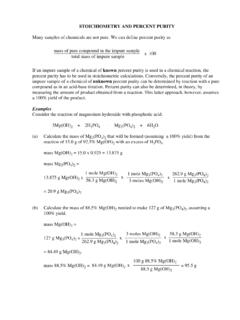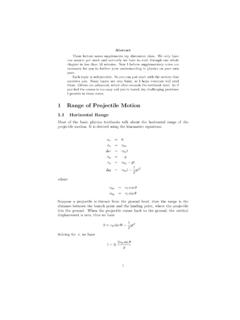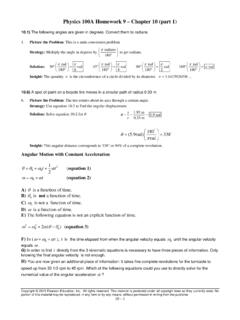Transcription of Physics 1120: 2D Kinematics Solutions - Kwantlen Polytechnic …
1 Questions: 1 2 3 4 5 6 7 8 9 10 11. Physics 1120: 2D Kinematics Solutions 1. In the diagrams below, a ball is on a flat horizontal surface. The inital velocity and the constant acceleration of the ball is indicated. Describe qualitatively how motion the motion of the ball will change. As time passes, the velocity will tend to point in the direction of a. 2. A particle has initial position r0 = <5 m, 3 m, 0 m> and initial velocity v0 = < m/s, 4 m/s, 2 m/s>. The acceleration is constant, a = <3 m/s2, 4 m/s2, 2m/s2>. Find the position of the particle after t = seconds. What was the magnitude of the particle's displacement during this time?
2 The i, j, and k components are completely independent of one another. The final x position of the particle depends only on the x components, similarly for the y and z components. Thus the problem reduces to handling three 1D Kinematics problems. For the given information, we use our Kinematics equation to find x, y, and z. Thus the final displacement is thus r = <x, y, z> = < m, m, m>. The magnitude of the displacement is found by using the 3D version of Pythagoras' Theorem: . The straight line distance between the starting and end points is m. To find the final position of the particle, one must examine the definition of displacement, r = rf r0, which can be rearranged into rf = r0 + r.
3 Thus we find that rf = r0 + r = <5 m, 3 m, 0 m> + < m, m, m> = < m, m, m>. 3. You are trapped on the top of a burning building. Death is imminent and help is nowhere in sight. There is a safe building m away and m lower. You decide to try and make it across. You run horizontally off your building at m/s. Do you make it across? If you don't, how much faster must you be going? First we sketch the situation and possible outcomes. While you are jumping, you are a projectile. We solve projectile motion problems by considering the x and y components separately, keeping in mind that the time in air is common. We write out the i and j information in separate columns including the information that we can infer or that we are supposed to know like the fact that running horizontally implies that voy = i j xsafe = m ysafe = m minus indicates down No x component ax = 0 ay = g = m/s2 gravity acts down for projectiles horizontal takeoff means v0x = m/s v0y = 0 m/s no vertical component tair = ?
4 Common tair = ? Looking at the x information, we see that we have enough data to find tair. The Kinematics equation that has all four quantities is x = v0xt + axt2. Since ax = 0 for a projectile, this equation become x = v0xt. Solving for t, we get t = x / v0x = ( m) / ( m/s) = s . This is the time it would take you to cross a horizontal distance of m. You must be in the air for at least this long if you are to safely make it across to the next building. On the other hand, looking at the y information, we see that we also have enough data to find tair. The Kinematics equation that has all four quantities is y = v0yt + ayt2.
5 We know v0y = 0 since you ran off the roof horizontally and that ay = g, thus this equation becomes y = gt2. Solving for t, we get t = { 2 y / g } = {( 2 m) / ( m/s) } = s . This is the time it takes you to fall a vertical distance of m. If you do reach the other building, then this is how long you were in the air. Since the time it takes to cross the horizontal distance is less than the time you have, you have don't make it across. To make it across safely you of course would need to run off the roof faster. Since ax = 0 for projectiles, the Kinematics equation become x = v0xt where t is now the s. Solving for v0x, we get , v0x = x / t = ( m) / ( s) = m/s.
6 If you were able to run at m/s you would safely make it to the other building. 4. A stunt motorcyclist is trying to jump over fifteen buses set side to side. Each bus is m wide and a ramp has been installed on either side of the line of buses. What is the minimum speed at which she must travel to safely reach the other side. How long will she be in the air? First we sketch the situation and possible outcomes. While the motorcyclist is jumping, she is a projectile. We solve projectile motion problems by considering the x and y components separately, keeping in mind that the time in air is common. We write out the i and j information in separate columns including the information that we can infer or that we are supposed to know.
7 We see from the sketch that if the motorcyclist is successful, then this is an example of level to . level flight and y = 0. Note that the initial velocity is broken into components. i j xsafe = 15 m = ysafe = 0 level to level flight m No x component ax = 0 ay = g = m/s2 gravity acts down for projectiles v0x = v0 cos v0 is unknown v0y = v0 sin . tair = ? common tair = ? common Looking at the x any y information, we see that we have two unknowns, v0 and t, for both. While we cannot solve any equation for x or y since there are two unknowns, both can be solved together. The appropriate Kinematics equations that has all four quantities for x and for y is: x = v0xt + axt2 , and y = v0yt + ayt2.
8 We substitute in known quantities to get x = v0 cos t , and 0 = v0 sin t gt2. We can divide the second equation by t and we get x = v0 cos t, and v0 sin = gt. We rewrite the first equation as t = x / v0 cos, which we substitute into the second equation to get v0. sin= g[ x / v0 cos ]. Getting v0 by itself we have v0 = {g/(2sin cos )} . Plugging in the appropriate numbers, we get v0 = m/s = km/h. Since is the speed that the motorcyclist must have on liftoff to successfully reach the other ramp. We can substitute this value into t = x / v0 cos to find the time in air to be s. 5. A boy throws a rock with speed v = m/s at an angle of = over a building.
9 The rock lands on the roof m in the x direction from the boy. How long was the rock in the air? How much taller, height h, is the building than the boy? Ignore air resistance. The rock is a projectile. We solve projectile motion problems by considering the x and y components separately, keeping in mind that the time in air is common. We write out the i and j information in separate columns including the information that we can infer or that we are supposed to know. We see from the sketch that h = y, the vertical displacement. Note that the initial velocity is broken into components. i j x = m y = h No x component ax = 0 ay = g = m/s2 gravity acts down for projectiles v0x = v0 cos v0y = v0 sin.
10 = cos(57 ) = sin(57 ). = m/s = m/s tair = ? common tair = ? common Looking at the x information, we see that we have enough data to find tair. The Kinematics equation that has all four quantities is x = v0xt + axt2. Since ax = 0 for a projectile, this equation become x = v0xt. Solving for t, we get t = x / v0x = ( m) / ( m/s) = s . Looking at the y information, we see that we now have enough data to find h. The Kinematics equation that has all four quantities is y = v0yt + ayt2. Since y = h and ay = g, this equation become h = v0yt . gt2. Substituting in the appropriate numbers reveals that h = m. The building is m taller that the boy where we have assumed that the ball left the boy's hand at head height which is a reasonable assumption.














